
Herbs to Boost Creative Power
If you are looking to boost creative power and cultivate more clarity in 2020, the classical Ayurvedic formula, Saraswati churna, may become your new herbal ally!
Aptly named after the Hindu goddess of art, music, and wisdom, Saraswati churna combines tonifying and clarifying nervines, as well as warming digestives. The goddess Saraswati is especially revered by artists and anyone on the creative path: “Creativity is her siddhi (special power) and for this reason, she is worshipped by every Indian artist” (Dass, 2015). Saraswati churna, a time-tested herbal blend designed to support clear expression and a calm, focused mind, is an apt choice for students, artists, or anyone looking to rejuvenate their mind, free their voice, and boost creative power.
What is Creative Power, and Why Does It Matter?
The life of the artist is not for everyone, but regardless of your chosen path, having creative power matters. Creativity is one’s ability to do just that—create. The product of your creativity could be a piece of writing, a film, a recipe, or a sheaf of music. Or, it could be a small business or a family. Creativity is essential in realizing our dreams and visions. Anything that manifests itself from thought into action involves creativity. In addition to a clear mind, the ability to express one’s thoughts and dreams clearly is essential in cultivating creative power. This is why the throat region and throat chakra are part of strengthening one’s creative power.
The vishuddha chakra, or throat chakra, is an energetic center that relates to one’s ability to express clearly. When someone is blocked or stuck in the throat chakra, it may be difficult for them to manifest their ideas and to clearly express their thoughts and feelings.
How Saraswati churna Can Help Boost Creative Power
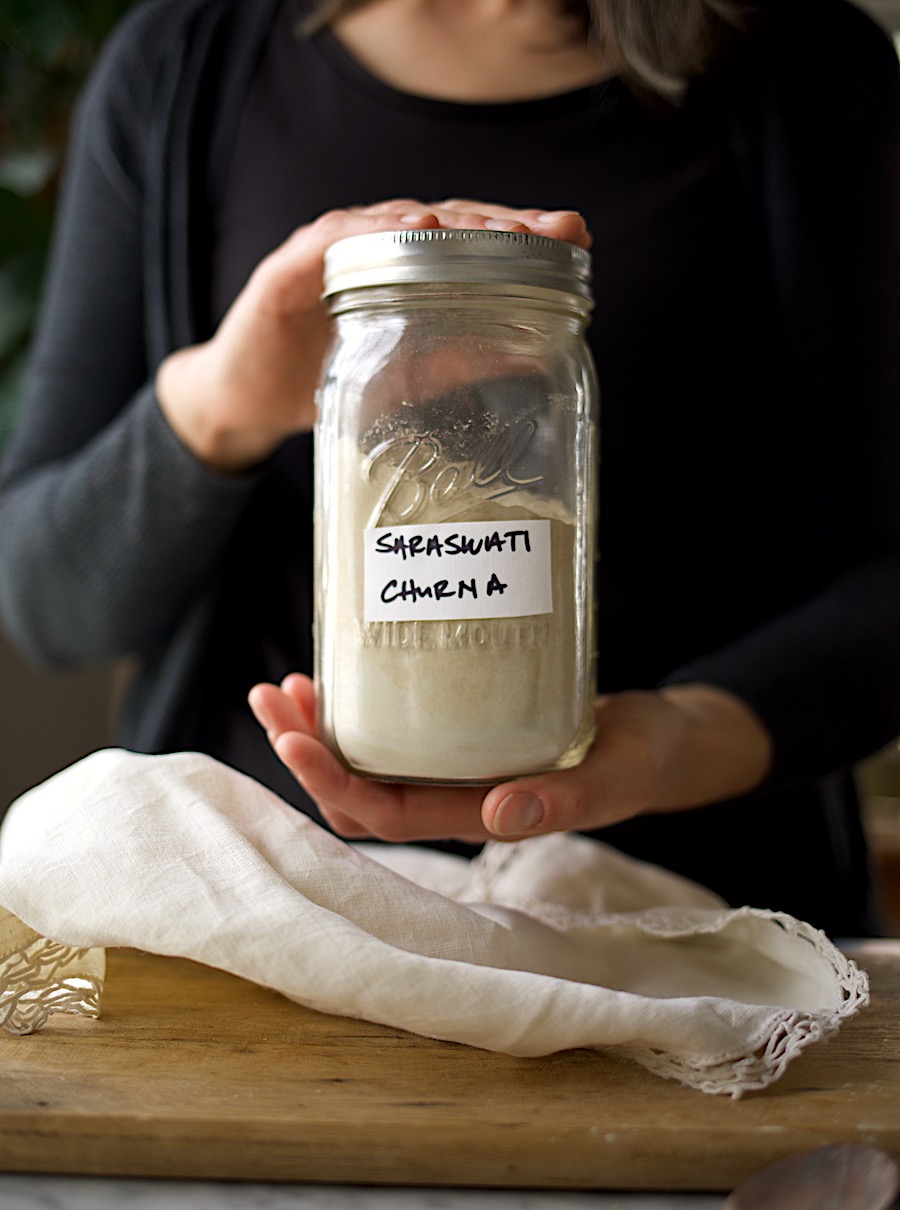
Saraswati churna’s ability to boost creative power in an individual comes from a skillful blend of herbs that target the throat region and that both calm and strengthen the nervous system. Thus, encouraging clarity of thought and self-expression.
You can make this formula yourself by combining equal parts of the powdered herbs summarized below. Depending on how large a batch you want to make, a part can be a tablespoon or more. To learn more about parts, read our blog post, What Exactly Are “Parts” In Herbal Recipes?
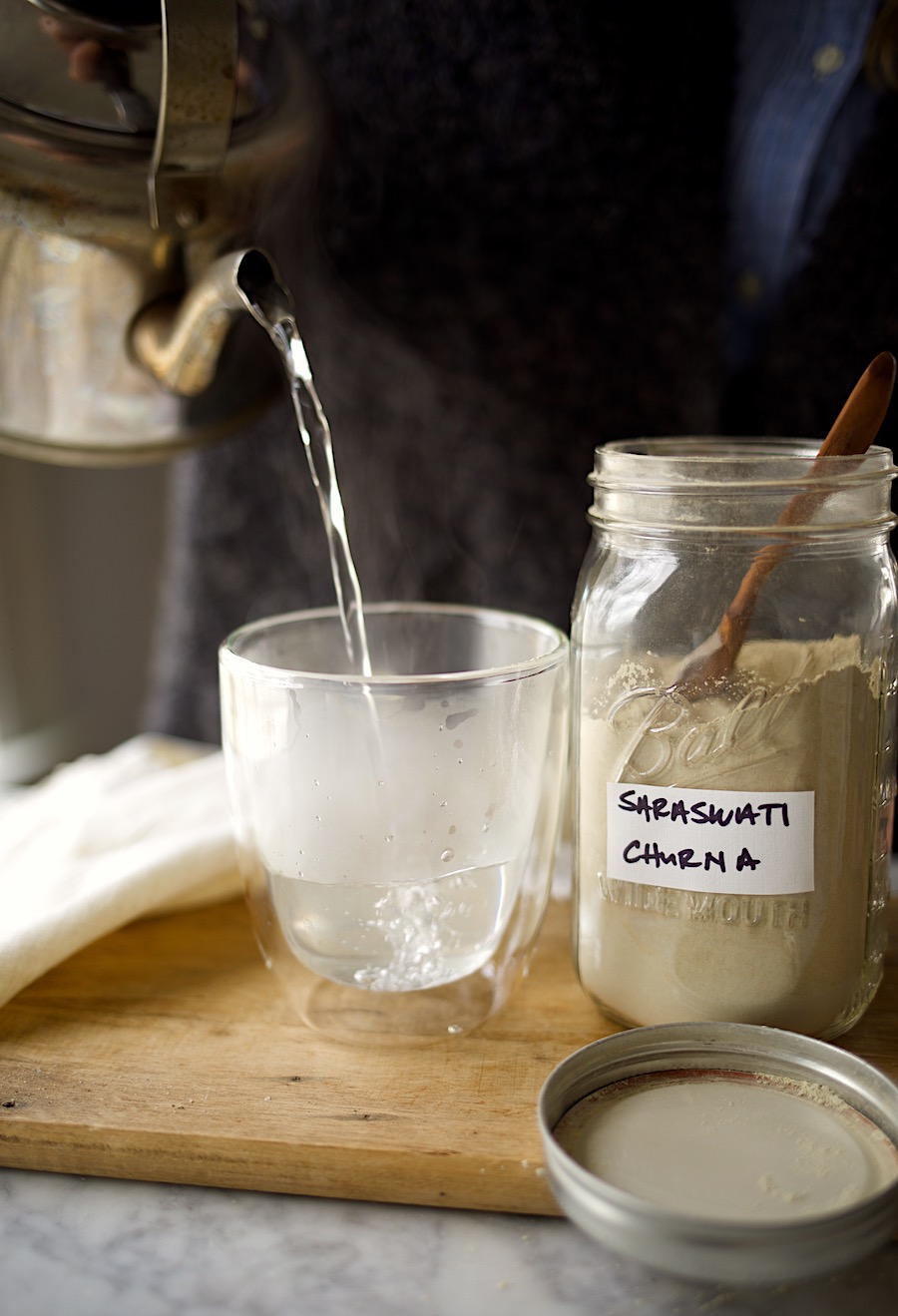
Ashwagandha (Withania somnifera) root powder: 1 part
Calamus (Acorus calamus) root powder: 1 part
Shankapushpi (Evolvulus alsinoides) aerial parts powder: 1 part
Ajwan (Trachyspermum ammi) seed powder: 1 part
Cumin (Cuminum cyminum) seed powder: 1 part
Guduchi (Tinospora cordifolia) stem powder: 1 part
Bibhitaki (Terminalia bellirica) fruit powder: 1 part
Alternately, if accessing all of the above herbs feels overwhelming, you can order pre-made Saraswati churna from ayurvedic herbal suppliers. The recommended dosage is 1-3 grams of the powder 2-3 times per day. You can take this formula in hot water or hot milk (vegan substitutes are fine) (Dass, 2013), or you can mix one teaspoon of Saraswati churna with one teaspoon of honey and lick it right off the spoon! Powdered churnas typically remain potent for about 6 months if kept in a sealed container and out of direct sunlight.
Now let’s take a closer look at the individual components in Saraswati churna so that we can better understand how this classical formula can support feelings of calm and clarity, as well as boost creative power and confidence in an individual.
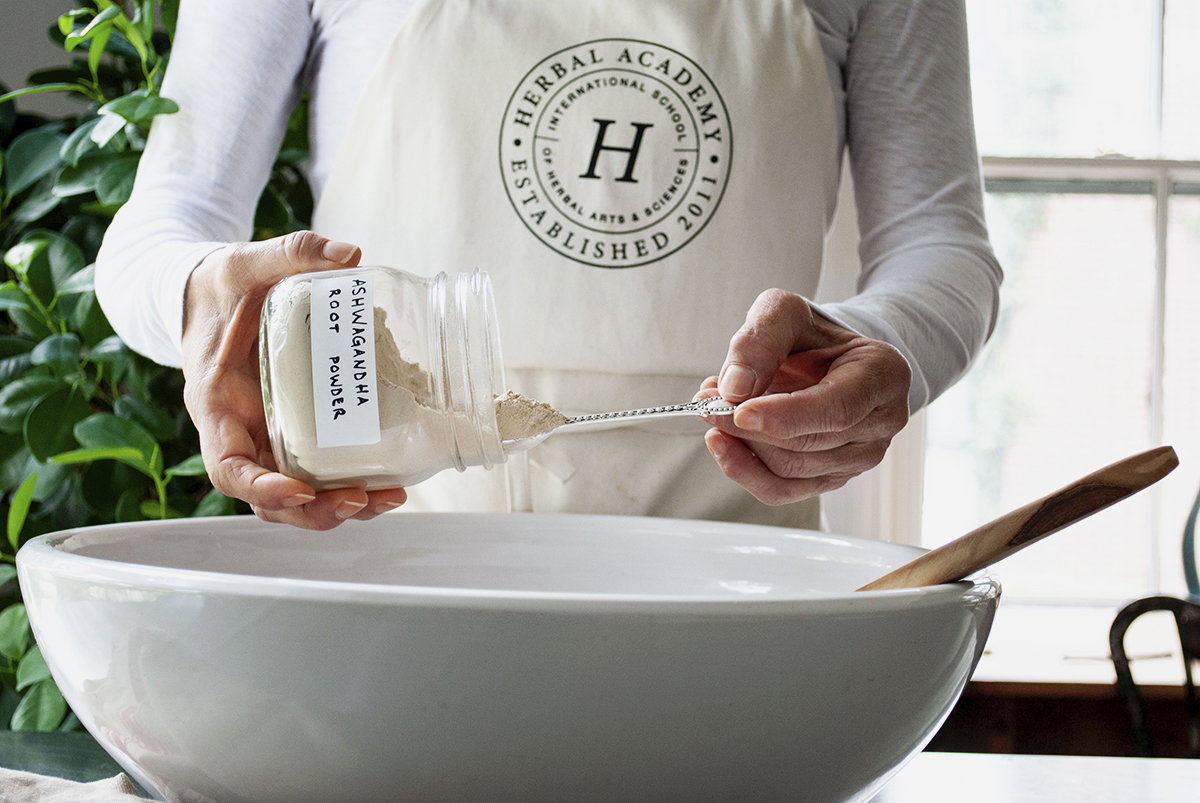
Ashwagandha (Withania somnifera) root
To get the big picture on ashwagandha, check out The Beginner’s Guide to Ashwagandha. However, in a nutshell, this starchy root is the go-to Ayurvedic herb for most vata-type imbalances, particularly of a psycho-emotional nature. Ashwagandha supports sound, regular sleep as well as a calm and steady mind. Therefore, it is traditionally used for insomnia, nervousness, stress, fatigue, overwork, and general debility (Dass, 2013).
Calamus (Acorus calamus) root
This peppery-tasting root has a pungent, bitter, and astringent taste. Calamus has a warm energy and an overall purifying effect on the body, and it also has a clarifying effect on the mind. It is traditionally used to soothe vata and kapha imbalances, such as colds, cough, congestion, and sinus headaches. It may also be helpful in cases of digestive weakness, anxiety, and memory loss. This herb supports focus, mental clarity, awareness, and memory, making it a key component in Saraswati churna.
Calamus has a prabhav, or special affinity, for the throat region. In fact, another name for calamus is vacha, which refers to speech and the throat. Thus, calamus may be useful in cases of speech impediment, loss of speech, and any hindrance in self-expression (Dass, 2013).
Shankapushpi (Evolvulus alsinoides) aerial parts
Like ashwagandha, shankapushpi has a rejuvenating effect on the mind and nervous system. However, shankapushpi’s energetics are slightly different compared to ashwagandha. Though tonifying, it is lighter and cooler than ashwagandha and is pacifying to all three doshas. Shankapushpi is used by ayurvedic practitioners in cases of depression, epilepsy, memory loss, sluggish liver, and insomnia. It may also be supportive for attention deficit disorder (ADD) and attention deficit/hyperactivity disorder (ADHD) due to the herb’s calming and rejuvenating effects on the nervous system. Interestingly enough, like calamus, shankapushpi is also supportive for speech impediments, thereby bolstering the effects of calamus in Saraswati churna and making it a great herb for boosting mental clarity. Shankapushpi is generally safe to consume in generous amounts (3-12 grams per day). There are no major cautions with shankapushpi, but it has a mildly sedative effect, so if you take and sedative medications, check with your healthcare provider before using this plant (Dass, 2013).
Ajwan (Trachyspermum ammi) seed
If you are looking for a potent and warming digestive stimulant, look no further than ajwan seed! Thanks to its flavor and aroma, these tiny dark seeds are often used in Indian cooking to add heat and to stimulate the agni (digestive fire). But be warned—a little pinch goes a long way! Just the right amount of ajwan can boost agni and stimulate the appetite, but too much will likely burn all the way down. Ajwan seeds have a carminative effect and are useful in cases of low appetite, constipation, excess gas, and sluggish digestion (Dass, 2013).
Ajwan seeds are also beneficial for the lungs and sinuses, serving as a decongestant. Ayurvedic practitioner Vishnu Dass suggests chewing a pinch of these potent seeds along with a pinch of rock salt and one clove (Syzygium aromaticum) to soothe sore throats and hoarseness. Another way to use ajwan is to boil a teaspoon of the seeds along with a little black tea and then use this as a steam inhalation for sinus and lung congestion (Dass, 2013).
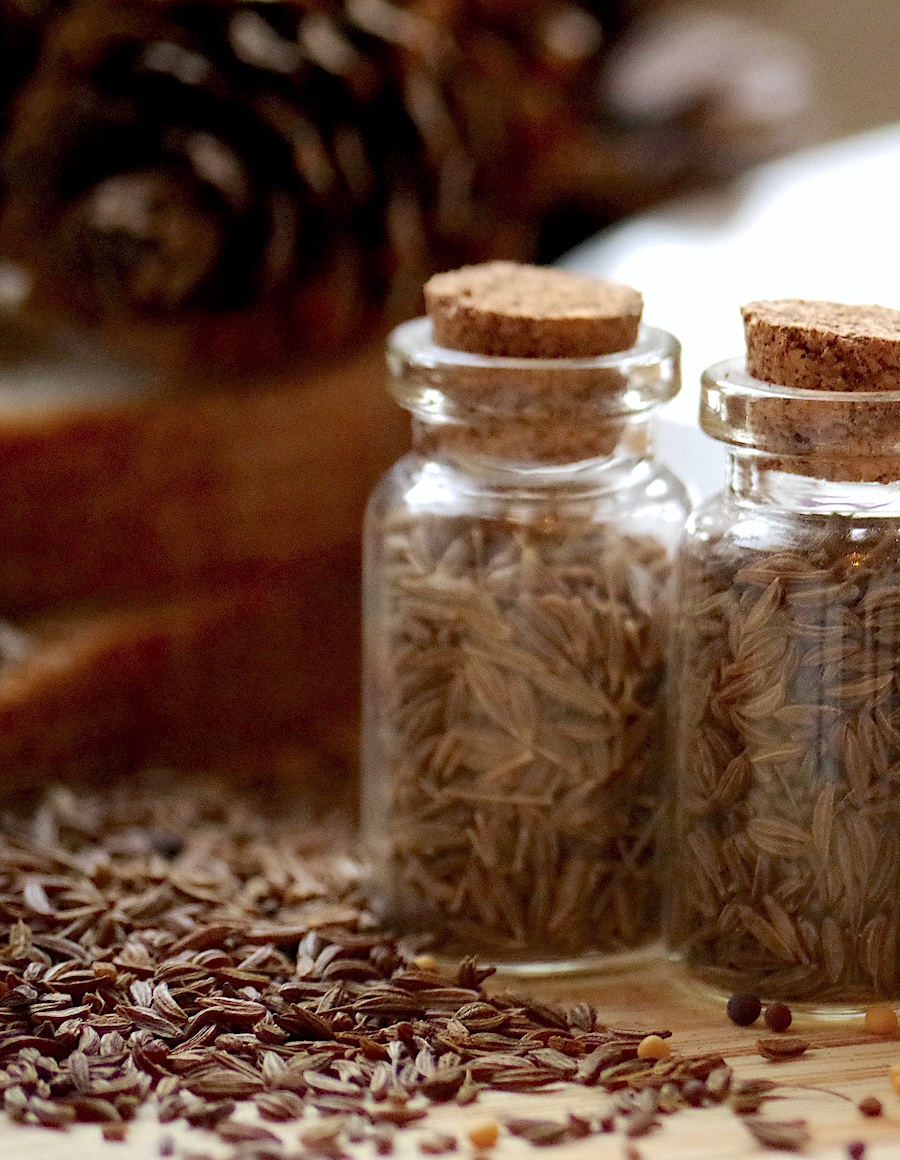
Cumin (Cuminum cyminum) seed
Another aromatic seed with a digestive punch is cumin, which, like ajwan, is also commonly used as a cooking spice. However, cumin has a milder flavor. It initially has a pungent and bitter taste with a cooling energy as well as a purifying effect on the body. Due to its cool energy, cumin stokes the digestive fire without overheating the body or aggravating pitta dosha (Dass, 2013). In Saraswati churna, it serves as a dipana, meaning it helps one to digest the other ingredients, which allows the other herbs in this blend to go to work clearing blockages and boosting creative power. Also, since cumin helps stoke agni, it dispels cold and dampness associated with vata and kapha doshas, respectively.
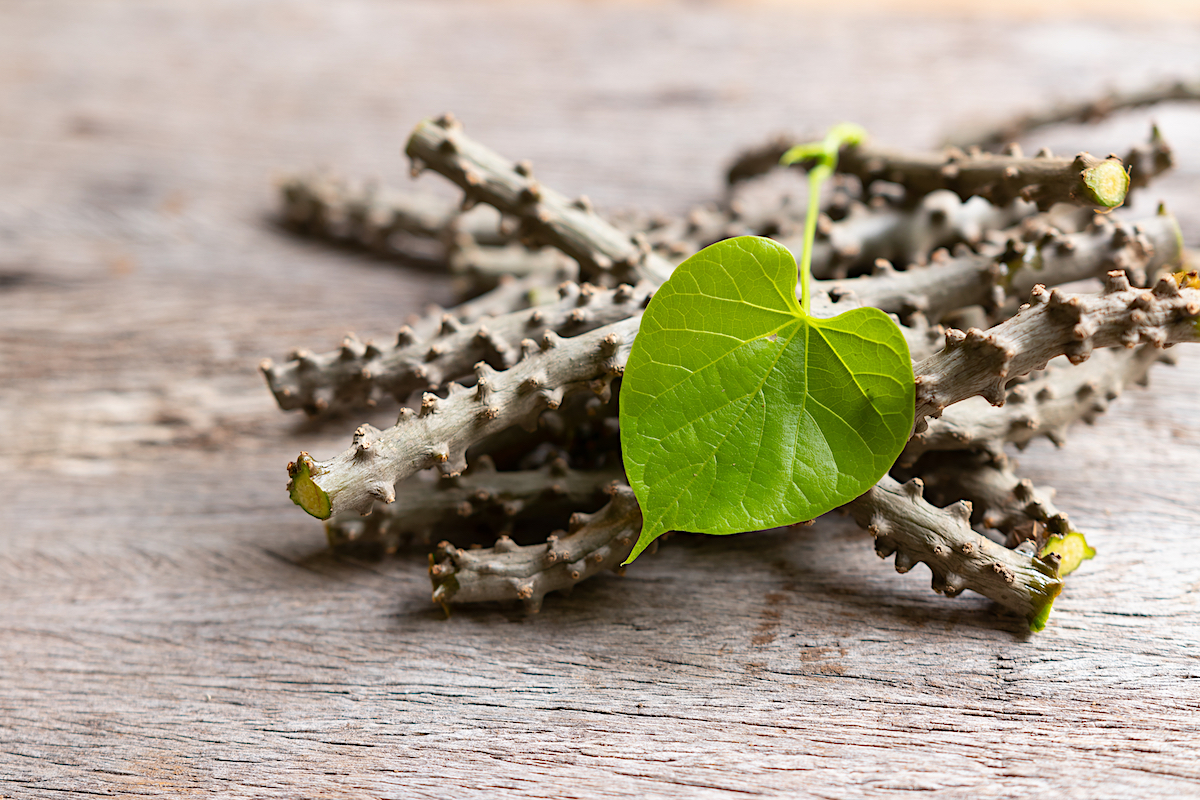
Guduchi (Tinospora cordifolia) stem
Guduchi is a wonderful liver support herb. It is traditionally used to support a healthy immune system and to pacify pitta imbalances, both of which are commonly associated with the liver. Guduchi is also known as amrit, meaning nectar, because it has a powerful rejuvenating effect on the liver, blood, and immune system (Dass, 2013). In Saraswati churna, guduchi plays an important role by contributing to the overall rejuvenative power of the blend. In order to boost creative power and free the channels of expression, it is helpful to be grounded, nourished, and well-rooted. Rejuvenating herbs such as guduchi and ashwagandha do their part by bolstering the body’s natural strength and ability to recover from stress.
Bibhitaki (Terminalia bellirica) fruit
Bibhitaki fruit has an astringent taste, a hot energy, and a rejuvenating effect on the body. It is beneficial for clearing blockages in the digestive, urinary, and respiratory tracts. Bibhitaki is one of the key ingredients in the famous ayurvedic formula, triphala (a wonderful digestive blend). However, beyond its agni boosting properties, bibhitaki is also soothing to the throat (there’s that vishuddha chakra again), and when combined with honey, turmeric, and hot water, can make a nice gargle for a hoarse, sore throat (Dass, 2013).
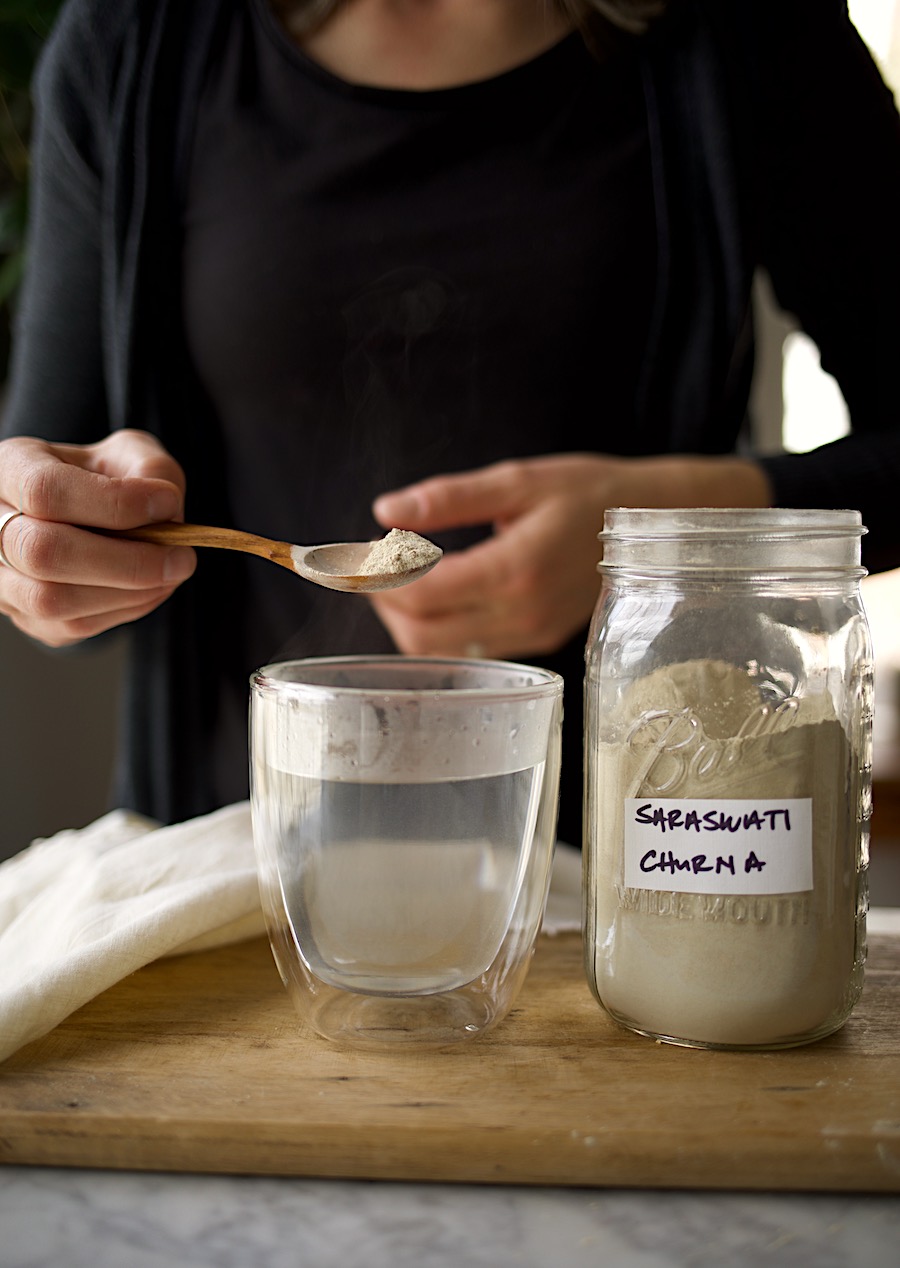
Free Your Voice
Saraswati churna is traditionally used for anxiety, mania, poor memory, epilepsy, paralysis, and speech disorders (Dass, 2013). The versatility of this time-tested formula is apparent. Not only does Saraswati churna strengthen the nervous system, liver, and mind, but it has a special ability to free both physical and emotional obstructions in the throat region. This special blend is soothing to the throat and the throat’s subtle counterpart, the vishuddha chakra, making it a fascinating formula to boost creative power. Perhaps 2020 is your time to invoke your creative power like never before, with a little help from your herbal friends.
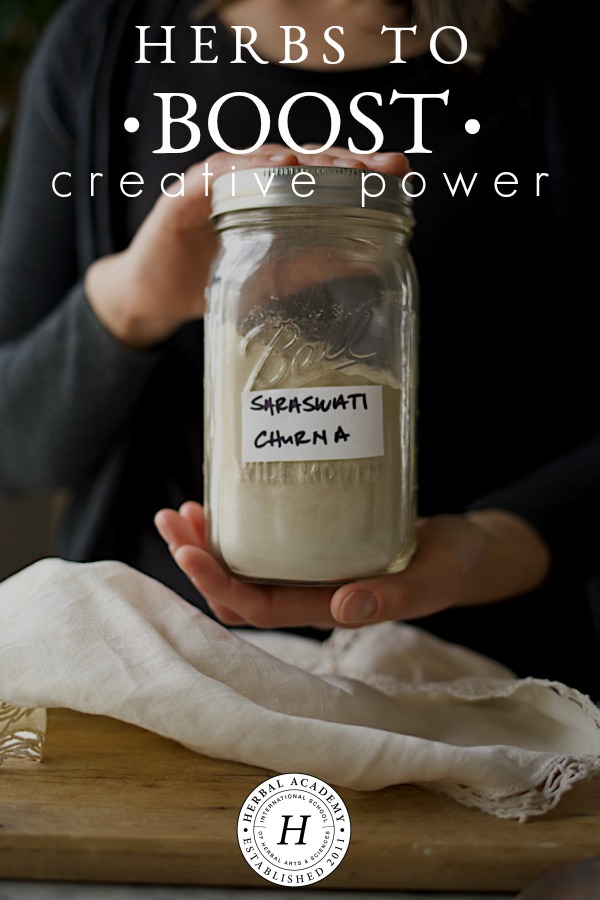
REFERENCES
Dass, R. (2015). The story of Saraswati. Retrieved from https://www.ramdass.org/the-story-of-saraswati/
Dass, V. (2013). Ayurvedic herbology: East and West. Twin Lakes, WI: Lotus Press.








